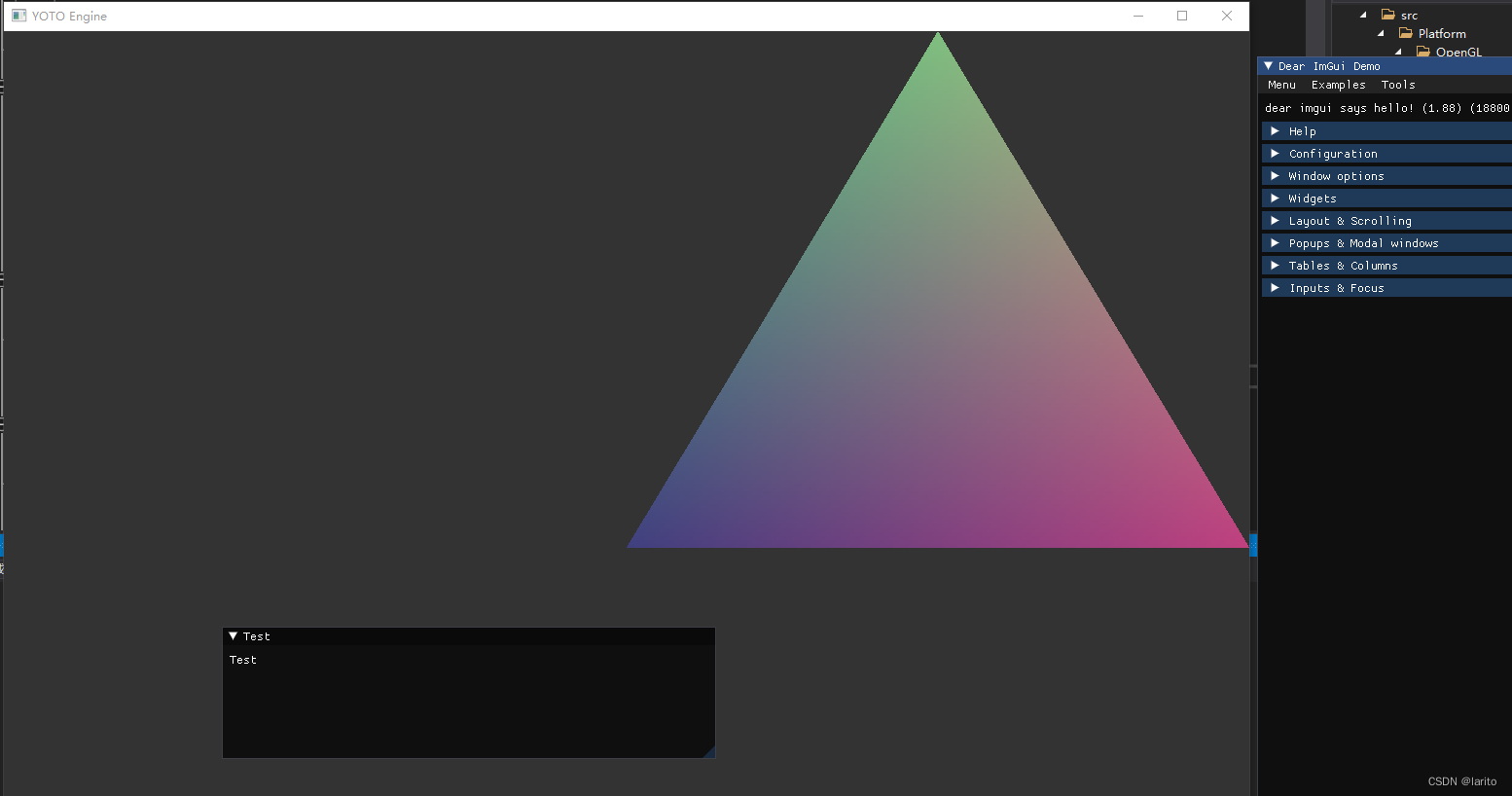创建着色器类:
shader.h:初始化、绑定和解绑方法:
#pragma once
#include <string>
namespace YOTO {
class Shader {
public:
Shader(const std::string& vertexSrc, const std::string& fragmentSrc);
~Shader();
void Bind()const;
void UnBind()const;
private:
uint32_t m_RendererID;
}
;
}shader.cpp:主打一个粘贴代码
#include"ytpch.h"
#include "Shader.h"
#include <glad/glad.h>
#include <YOTO/Log.h>
namespace YOTO {
Shader::Shader(const std::string& vertexSrc, const std::string& fragmentSrc)
{
// 1.1.创建顶点着色器对象
GLuint vertexShader = glCreateShader(GL_VERTEX_SHADER);
// Send the vertex shader source code to GL
// Note that std::string's .c_str is NULL character terminated.
// 1.2.附加顶点着色器源码到顶点着色器对象中
const GLchar* source = vertexSrc.c_str();
glShaderSource(vertexShader, 1, &source, 0);
// 1.3.编译顶点着色器对象
glCompileShader(vertexShader);
// 1.4.检查是否编译成功
GLint isCompiled = 0;
glGetShaderiv(vertexShader, GL_COMPILE_STATUS, &isCompiled);
if (isCompiled == GL_FALSE) {
// 1.4.2编译失败可以打印报错信息
GLint maxLength = 0;
glGetShaderiv(vertexShader, GL_INFO_LOG_LENGTH, &maxLength);
// The maxLength includes the NULL character
std::vector<GLchar> infoLog(maxLength);
glGetShaderInfoLog(vertexShader, maxLength, &maxLength, &infoLog[0]);
// We don't need the shader anymore.
glDeleteShader(vertexShader);
YT_CORE_ERROR("{0}", infoLog.data());
YT_CORE_ASSERT(false, "Vertex shader compilation failure!");
return;
}
// 片段着色器一样
// 2.1.创建片段着色器对象
GLuint fragmentShader = glCreateShader(GL_FRAGMENT_SHADER);
// Send the fragment shader source code to GL
// Note that std::string's .c_str is NULL character terminated.
// 2.2.附加片段着色器源码到片段着色器对象中
source = fragmentSrc.c_str();
glShaderSource(fragmentShader, 1, &source, 0);
// 2.3.编译片段着色器对象
glCompileShader(fragmentShader);
// 2.4.检查是否编译成功
glGetShaderiv(fragmentShader, GL_COMPILE_STATUS, &isCompiled);
if (isCompiled == GL_FALSE) {
// 2.4.2编译失败可以打印报错信息
GLint maxLength = 0;
glGetShaderiv(fragmentShader, GL_INFO_LOG_LENGTH, &maxLength);
// The maxLength includes the NULL character
std::vector<GLchar> infoLog(maxLength);
glGetShaderInfoLog(fragmentShader, maxLength, &maxLength, &infoLog[0]);
// We don't need the shader anymore.
glDeleteShader(fragmentShader);
// Either of them. Don't leak shaders.
glDeleteShader(vertexShader);
YT_CORE_ERROR("{0}", infoLog.data());
YT_CORE_ASSERT(false, "Fragment shader compilation failure!");
return;
}
// Vertex and fragment shaders are successfully compiled.
// Now time to link them together into a program.
// Get a program object.
// 3.1创建着色器程序对象
m_RendererID = glCreateProgram();
GLuint program = m_RendererID;
// 3.2附加着色器对象给着色器程序对象
glAttachShader(program, vertexShader);
glAttachShader(program, fragmentShader);
// 3.3链接着色器程序对象
glLinkProgram(program);
// 3.4可以检查链接是否成功
// Note the different functions here: glGetProgram* instead of glGetShader*.
GLint isLinked = 0;
glGetProgramiv(program, GL_LINK_STATUS, (int*)&isLinked);
if (isLinked == GL_FALSE) {
GLint maxLength = 0;
glGetProgramiv(program, GL_INFO_LOG_LENGTH, &maxLength);
// The maxLength includes the NULL character
std::vector<GLchar> infoLog(maxLength);
glGetProgramInfoLog(program, maxLength, &maxLength, &infoLog[0]);
// We don't need the program anymore.
glDeleteProgram(program);
// Don't leak shaders either.
glDeleteShader(vertexShader);
glDeleteShader(fragmentShader);
YT_CORE_ERROR("{0}", infoLog.data());
YT_CORE_ASSERT(false, "Shader link failure!");
return;
}
// 4.删除着色器对象
// Always detach shaders after a successful link.
glDetachShader(program, vertexShader);
glDetachShader(program, fragmentShader);
}
Shader::~Shader()
{
glDeleteProgram(m_RendererID);
}
void Shader::Bind() const
{
glUseProgram(m_RendererID);
}
void Shader::UnBind() const
{
glUseProgram(0);
}
}Shader和着色器类的使用:
Application.h:添加Shader类的指针
#pragma once
#include"Core.h"
#include"Event/Event.h"
#include"Event/ApplicationEvent.h"
#include "YOTO/Window.h"
#include"YOTO/LayerStack.h"
#include"YOTO/ImGui/ImGuiLayer.h"
#include <YOTO/Renderer/Shader.h>
namespace YOTO {
class YOTO_API Application
{
public:
Application();
virtual ~Application();
void Run();
void OnEvent(Event &e);
void PushLayer(Layer* layer);
void PushOverlay(Layer* layer);
inline static Application& Get() {return * s_Instance;}
inline Window& GetWindow() { return *m_Window; }
private:
bool OnWindowClosed(WindowCloseEvent& e);
std::unique_ptr<Window> m_Window;
ImGuiLayer * m_ImGuiLayer;
bool m_Running = true;
LayerStack m_LayerStack;
unsigned int m_VertexArray, m_VertexBuffer, m_IndexBuffer;
std::unique_ptr<Shader> m_Shader;
static Application* s_Instance;
};
//在客户端定义
Application* CreateApplication();
}
Application.cpp:实例化着色器并在Run的循环中绑定
#include"ytpch.h"
#include "Application.h"
#include"Log.h"
#include<glad/glad.h>
#include"Input.h"
namespace YOTO {
#define BIND_EVENT_FN(x) std::bind(&x, this, std::placeholders::_1)
Application* Application::s_Instance = nullptr;
Application::Application() {
YT_CORE_ASSERT(!s_Instance, "Application需要为空!")
s_Instance = this;
//智能指针
m_Window = std::unique_ptr<Window>(Window::Creat());
//设置回调函数
m_Window->SetEventCallback(BIND_EVENT_FN(Application::OnEvent));
//new一个Layer,放在最后层进行渲染
m_ImGuiLayer = new ImGuiLayer();
PushOverlay(m_ImGuiLayer);
//unsigned int id;
//glGenBuffers(1, &id);
//顶点数组:
glGenVertexArrays(1, &m_VertexArray);
glBindVertexArray(m_VertexArray);
//顶点缓冲区
glGenBuffers(1, &m_VertexBuffer);
glBindBuffer(GL_ARRAY_BUFFER,m_VertexBuffer);
float vertices[3 * 3] = {
-0.5f,-0.5f,0.0f,
0.5f,-0.5f,0.0f,
0.0f,0.5f,0.0f,
};
//把数据传送给gpu,GL_STATIC_DRAW不断的用新数据刷新数组。告诉opengl这个缓冲区的数据布局
glBufferData(GL_ARRAY_BUFFER, sizeof(vertices), vertices, GL_STATIC_DRAW);
//启用数据的索引0
glEnableVertexAttribArray(0);
//设置缓冲区数据格式:缓冲区序号、顶点属性的大小、什么数据类型、会不会被归一化、
glVertexAttribPointer(0, 3, GL_FLOAT, GL_FALSE, 3 * sizeof(float),nullptr);
//创建索引缓冲区
glGenBuffers(1, &m_IndexBuffer);
glBindBuffer(GL_ELEMENT_ARRAY_BUFFER, m_IndexBuffer);
unsigned int indices[3] = { 0,1,2 };
//设置缓冲区格式
glBufferData(GL_ELEMENT_ARRAY_BUFFER, sizeof(indices), indices, GL_STATIC_DRAW);
//着色器
//顶点布局
std::string vertexSource = R"(
#version 330 core
layout(location = 0) in vec3 a_Position;
out vec3 v_Position;
void main(){
v_Position=a_Position;
gl_Position =vec4( a_Position+0.5,1.0);
}
)";
//绘制颜色
std::string fragmentSource = R"(
#version 330 core
layout(location = 0) out vec4 color;
in vec3 v_Position;
void main(){
color=vec4(v_Position*0.5+0.5,1.0);
}
)";
m_Shader.reset(new Shader(vertexSource, fragmentSource));
//shader
}
Application::~Application() {
}
/// <summary>
/// 所有的Window事件都会在这触发,作为参数e
/// </summary>
/// <param name="e"></param>
void Application::OnEvent(Event& e) {
//根据事件类型绑定对应事件
EventDispatcher dispatcher(e);
dispatcher.Dispatch<WindowCloseEvent>(BIND_EVENT_FN(Application::OnWindowClosed));
//输出事件信息
YT_CORE_INFO("Application:{0}",e);
for (auto it = m_LayerStack.end(); it != m_LayerStack.begin();) {
(*--it)->OnEvent(e);
if (e.m_Handled)
break;
}
}
bool Application::OnWindowClosed(WindowCloseEvent& e) {
m_Running = false;
return true;
}
void Application::Run() {
WindowResizeEvent e(1280, 720);
if (e.IsInCategory(EventCategoryApplication)) {
YT_CORE_TRACE(e);
}
if (e.IsInCategory(EventCategoryInput)) {
YT_CORE_ERROR(e);
}
while (m_Running)
{
glClearColor(0.2f, 0.2f, 0.2f,1);
glClear(GL_COLOR_BUFFER_BIT);
glBindVertexArray(m_VertexArray);
m_Shader->Bind();
glDrawElements(GL_TRIANGLES,3,GL_UNSIGNED_INT,nullptr);
for (Layer* layer : m_LayerStack) {
layer->OnUpdate();
}
//将ImGui的刷新放到APP中,与Update分开
m_ImGuiLayer->Begin();
for (Layer* layer : m_LayerStack) {
layer->OnImGuiRender();
}
m_ImGuiLayer->End();
m_Window->OnUpdate();
}
}
void Application::PushLayer(Layer* layer) {
m_LayerStack.PushLayer(layer);
layer->OnAttach();
}
void Application::PushOverlay(Layer* layer) {
m_LayerStack.PushOverlay(layer);
layer->OnAttach();
}
}测试:

cool!(水一期)





















 286
286











 被折叠的 条评论
为什么被折叠?
被折叠的 条评论
为什么被折叠?








